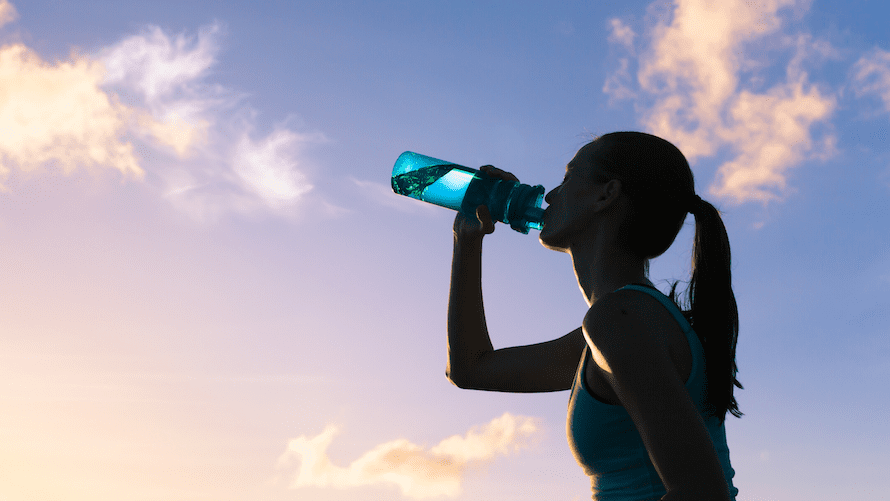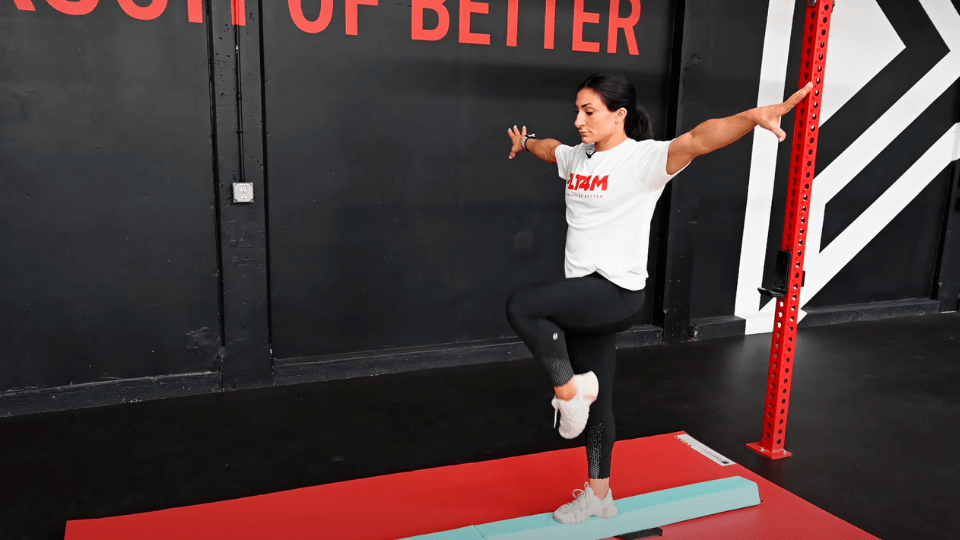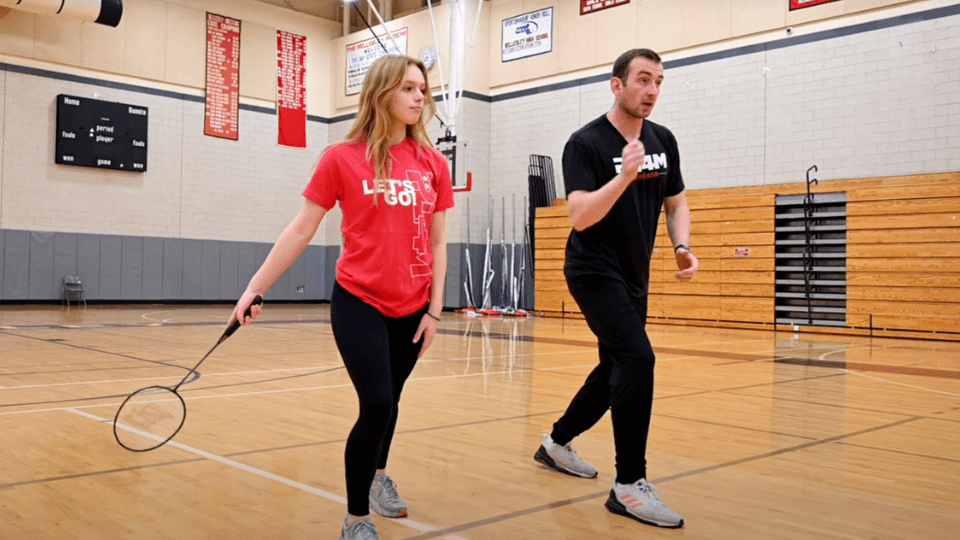There is a lot to unpack when it comes to hydration education. In this article, we pull from PLT4M’s Intro To Nutrition series to explore everything from water education, sweat science, and sports drinks. Learning about hydration education is important for everyone including everyday students to high-level competitive athletes. There is a lot to unpack with hydration education, so we have broken this article down into two parts: 1) Hydration 101 and 2) Sweat Science and Sports Drinks.
Hydration Education Part 1 – Hydration 101
To start our hydration education, let’s talk about WHAT water does for our body. Water is so special that it has its own category. While water doesn’t directly “do” anything, such as give the body energy like macronutrients or facilitate metabolic processes like micronutrients, it is crucial to healthy bodily function. Hydration education 101 facts include:
- H20 is part of every biochemical reaction in the body.
- Needed for digestion, absorption, transportation, dissolving nutrients, elimination of waste products (aka, going to the bathroom), thermoregulation (aka, sweating), and to cushion joints and organs.
- Macronutrients like protein, and stored glucose (called glycogen), contain water.
- Water fills the space between and inside of cells, and is what makes our blood “fluid.”
As a result, humans are mostly water. In fact, even though you can’t directly “see” it, the human body is made up of 50-80% water.
Most people have the misconception that if they’re not sweating, they don’t need water. But that’s completely false. Breathing, going to the bathroom, and casual cooling account for half of the water lost in a day (called, “insensible losses“). These all impact our fluid needs.
Here, though, we will investigate the essential nutrient – water.
Not including sweating, the human body goes through around 80-100 fluid ounces of water each day (or about 10-12 cups). And activities like exercising or training, especially in the hot climates, can increase the losses even more.
There are a lot of downsides to dehydration (or not having enough water in the body), ranging from inconvenient to deadly. Problems include headaches, dry skin, low energy, poor concentration, constipation, decreased athletic performance, and increased pain, to name a few. Dehydration also increases heart rate and affects kidney function. If the water status of the body gets too low, it can lead to death in a few days.
Check out a full presentation on hydration education part 1 from PLT4M nutrition expert Rebecca Toutant.
Where Do We Get Water?
To better understand hydration education, let’s explore where we get our water.
There are many ways to provide water for the human body – it does not (and should not) all come from drinking water directly. Some of our water needs can be met by food (e.g., there’s water in fruits/vegetables as well as most cooked meals, including meats, dairy, and grains). But approximately 80% of our water needs must be met by drinking something fluid.
In general, water is the best source of hydration. Additional options include sparkling water, decaffeinated tea, and milk. If you’re bored with plain water, consider adding flavor pick-ups like small splashes of fruit juice or fruit infused water.
Caffeinated drinks such as coffee and tea provide fluid, but that fluid leaves the body faster than the options mentioned above – so they don’t hydrate for long.
Juice, soda, and other sugar-sweetened beverages are tricky. Because while they do indeed hydrate, they also provide a large dose of sugar in the process. Sugar has its purpose in providing a fast burst of fuel. But using sugary drinks for hydrating gives the body more sugar than it knows what to do with (a 12 oz can of Pepsi has 41 grams of sugar or 10 teaspoons.) These options can play a small, fun role in hydration, but should not be the main option.
Sports drinks (Gatorade) and oral rehydration solutions (Pedialyte) are incredibly valuable tools to prevent and replace large fluid losses from sweating, vomiting, or diarrhea. But they are not necessary for day-to-day general hydration as they too come with a decent amount of sugar. But there’s a purpose for sugar in sports drinks – we’ll dive into that in part two of our hydration education.
How Much Water Do We Need?
There are many ways to measure fluid needs, but relying on thirst is NOT at the top of the list. Typically by the time we’re thirsty, we’re already dehydrated. Short of clinical laboratory tests, the most readily available way to gauge your hydration happens in the bathroom. Yes, let’s talk urine and how it relates to hydration education!
The frequency and color of urine is a good personal gauge for hydration. Urine should be a light or pale yellow color. Most bodies urinate 6-10 times a day. The darker the color and lower the frequency, the more likely you are to be dehydrated. Completely clear and frequent urine is a sign to dial down the fluids a bit. If you’re unsure how much is right for you, ask your doctor.
Please note that IT IS possible to drink too much water and overdue fluid intake. Water is part of a complicated balancing act with a series of vitamins and minerals called electrolytes. Electrolytes help control the water balance of the body and are often lost during the process of sweating.
When you drink excessive amounts of water without having adequate electrolytes, it can lead to a dangerous, life-threatening health condition called hyponatremia. This does not typically occur when someone is drinking water within reason over the course of the day. But can occur if attempting to drink high levels of fluid in a relatively short period.
Water is, in many ways, most of who we are, and it’s essential not only to live but to function at our best. Next, we’ll learn about hydrating for exercise and sports performance, and the role sports drinks like Gatorade play.
Ready to Learn More?
Schedule a free 10 minute consultation to see how PLT4M can help save you time and empower student learning!
Hydration Education Part 2 – Sweat Science and Sports Drinks
Staying hydrated is a crucial aspect of health. As we learned in Hydration Education Part 1, we talked about the what, where, and how of general hydration. We learned that the body goes through a lot of water each day. And those that are active and sweating lost even more water by way of sweating.
Sweat is not “pain leaving the body.” It’s also not “fat crying.” The purpose of sweating is to cool the body. Bodies need to maintain tight internal temperature control. A few degrees too hot or too cold can be dangerous. When sweat evaporates from the skin, it creates a cooling effect. Everyone has a different sweat rate depending on their genetics, training level, and body size.
Sweating is not a sign of weakness and it has nothing to do with the number of calories burned. Actually, those who are more fit tend to sweat sooner and heavier than those that are not.
While we need to sweat to maintain our internal temperature, we also need to maintain fluid balance- particularly during exercise. For people who are heavy sweaters, training over an hour, and/or training in hot weather, sports drinks can play an important role in exercise.
Check out a full presentation on hydration education part 2 from PLT4M nutrition expert Rebecca Toutant.
Sports Drinks
Beyond using them for exercise, sports drinks are not superior to water for hydration. Since they’re typically used for sport, many people get the impression that there’s something “magical” about them and that they hydrate better than water. They’re not magic – they are a science designed to fuel and hydrate sweaty bodies in motion.
They contain the necessary nutrients to keep active people hydrated and moving during long bouts of exercise and/or in hot temperatures. But for someone who is not exercising long periods and/or in hot weather, they have little to no benefit beyond other hydration options.
Additionally, more is not always better when it comes to sports drinks. While many come conveniently packaged anywhere from 20 – 128 oz, the body only benefits from small doses during exercise (typically 6-8 oz at a time). However, because they taste so good and “refreshing,” it can be easy to consume more than needed.
Sports drinks (such as Gatorade and Powerade) are a tasty tool designed to support the maintenance of hydration and energy during exercise. Three main ingredients support the process:
- Energy: Sports drinks contain easily digestible blends of sugar (namely glucose and fructose) in amounts the body can tolerate (and absorb) during times of sustained increased heart rate, such as during running, cycling, or swimming.
- Maintain hydration: Sports drinks have sodium, which helps the body hold on to water.
- Hydrate: Sports drinks contain fluid to replace what’s lost during sweating.
To understand the role of sports drinks, it’s essential to understand more about the human body. Sports drinks are a tool designed to be used in small, frequent doses over a long period, ideally during physical activity. They’re especially valuable for those exercising over an hour and who experience fluid and water loss by way of sweat.
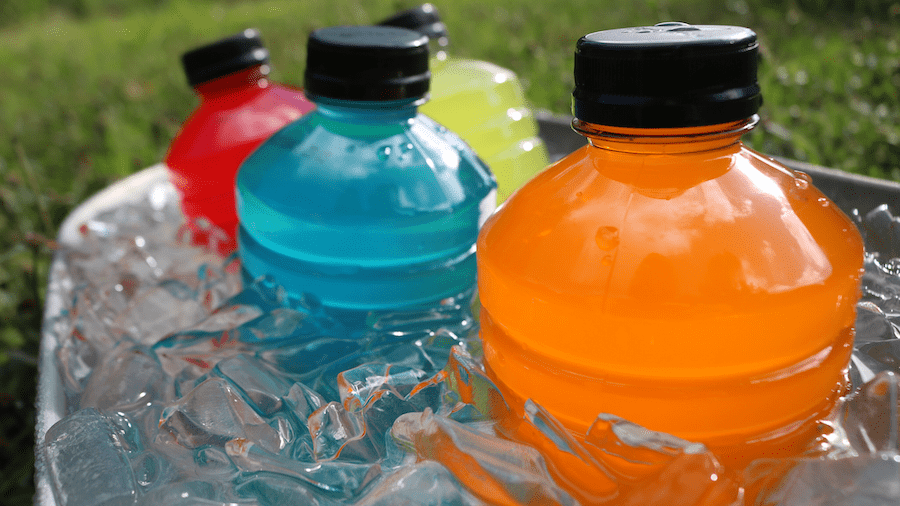
PRINCIPLE 1: SWEAT IS NOT JUST WATER.
The average person sweats .8 – 1.5 liters of fluid every hour of exercise, and it’s not uncommon for an athlete to sweat 3 liters or more per hour. We know athletic performance goes down a lot when a body is 2% dehydrated (or a 3.5 lb loss for a 180 lb body weight person OR a 2.5 lbs for a 120 lb body weight person).
Sweat contains a lot of sodium as well as chloride, potassium, calcium, and magnesium. These minerals are called “electrolytes” and support muscle contraction as well as fluid balance in the body. They’re also the reason some people who sweat a lot might have a white crust on their skin – those are the electrolytes (mostly sodium).
While the number of minerals lost can vary, 1 liter of sweat can contain upwards of 900 mg of sodium – that’s almost 50% of daily sodium needs. Sports Drinks contain a modest amount of sodium to increase thirst and to help replace some of what’s lost. And having sugar in the drink increases the rate of absorption of the sodium and fluid.
Hydration Education Side note: This is also why eating well after sport is so important! Fruits, vegetables, whole grains, and protein contain many of the electrolytes lost during physical activity. Learn more about these in our full Intro To Nutrition Lesson Plans.

PRINCIPLE 2: EXERCISE CHANGES DIGESTION.
There’s a large body of science behind sports drinks formulation, and much of it has to do figuring out how to fuel a body during physical activity. As heart rate increases with physical activity, the body’s ability to digest and absorb nutrients decreases.
The 6-8 oz serving of sports drinks provides around 8-12 grams of sugar – the amount of fuel most bodies can absorb within a 15-20 minute period without causing an upset stomach. Higher doses of sugar can cause nausea, vomiting, and diarrhea. Lower amounts fail to give the body enough energy. This is why it’s important not to water down or over concentrate sports drinks – it changes how the nutrients are absorbed and nourish the athlete.
Sweat contains a lot of sodium as well as chloride, potassium, calcium, and magnesium. These minerals are called “electrolytes” and support muscle contraction as well as fluid balance in the body. They’re also the reason some people who sweat a lot might have a white crust on their skin – those are the electrolytes (mostly sodium).
While the number of minerals lost can vary, 1 liter of sweat can contain upwards of 900 mg of sodium – that’s almost 50% of daily sodium needs. Sports Drinks contain a modest amount of sodium to increase thirst and to help replace some of what’s lost. And having sugar in the drink increases the rate of absorption of the sodium and fluid.
Hydration Education Side note: This is also why eating well after sport is so important! Fruits, vegetables, whole grains, and protein contain many of the electrolytes lost during physical activity.
Are Sports Drinks Required?
While the principles of hydration education are important, sports drinks are not “required” for hydration and/or fueling exercise. Sports drinks are valuable for:
- 1, Those who exercise/train over an hour to fuel activity and maintain hydration
- 2, Those who exercise/train in high temperatures to maintain hydration
- 3, Those who are heavy sweaters to maintain hydration
Those training over two hours, especially in the heat, sports drinks may not be enough. They may need to add supplemental foods to replace the glucose, sodium, and other electrolytes lost during sport and support necessary energy intake.
For those training for less than an hour, eating and hydrating properly before and after with water is enough to fuel the activity.
While sports drinks are designed to be used during physical activity, they can be used before or after to help people fuel up for their sport and/or rehydrate and refuel.
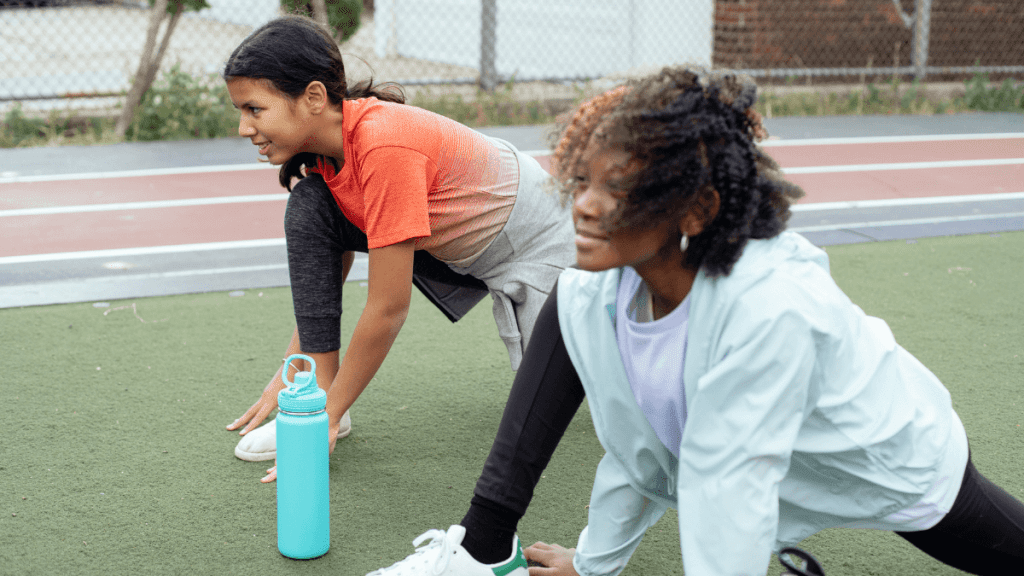
Before Training:
The goal of nutrition before exercise is to give the body the fuel it needs to move. Because once someone is exercising, the body can’t replace the fluid and fuel that the body uses as fast as it’s lost. If you go into exercise undernourished and/or dehydrated, it’s not realistic to think you can correct it while exercising. It’s better to go into exercise fueled and hydrated to perform best.
The body operates best when fueled and hydrated with a balanced meal or snack 2-3 hours before training, with enough carbohydrates to fuel their activity. For most people, carbohydrate needs 2-3 hours before sport can range from 45 – 90 grams (depending on genetics, age, sex, and physical activity).
To put that in food equivalencies, 45 grams of carbohydrate would be like having 2 slices of bread + fruit (along with your meat and veggies). And 90 grams is TWICE that amount of carbohydrate, which isn’t within everyone’s stomach capacity.
A 20 oz sports drink provides the equivalent energy as about two slices of white bread. But since sports drinks are exclusively sugar, they don’t give as much nutrient value as an alternative beverage such as milk (which also provides protein, calcium, potassium, and magnesium).
More On Sports Drinks and Before Training
Additionally, sports drinks are also a tool that can be used for a quick burst of energy that won’t upset the stomach within an hour of physical activity. But note that because all of the energy is coming from sugar, the energy is quickly used and won’t provide the same sustained fuel as having real food – but not everyone can tolerate that.
Finally, sodium is another important player in sports drinks to help maintain hydration. Most people get plenty of sodium in their day since it’s added to most meals and snacks in the form of table salt. While most Americans get too much sodium (from salt), those who are exercising more than an hour and/or in hot temperatures benefit from the sodium in salt to help them maintain fluid balances during exercise.
After Training:
Finally, sodium is another important player in sports drinks to help maintain hydration. Most people get plenty of sodium in their day since it’s added to most meals and snacks in the form of table salt. While most Americans get too much sodium (from salt), those who are exercising more than an hour and/or in hot temperatures benefit from the sodium in salt to help them maintain fluid balances during exercise.
If real foods aren’t appetizing, a blend of milk + frozen fruit is also a good hydration tool to help rehydrate, refuel, and get the nutrients needed. Other options include a glass of milk with a peanut butter sandwich OR water along with a turkey sandwich with tomato and cheese OR crackers and hummus with some fruit.
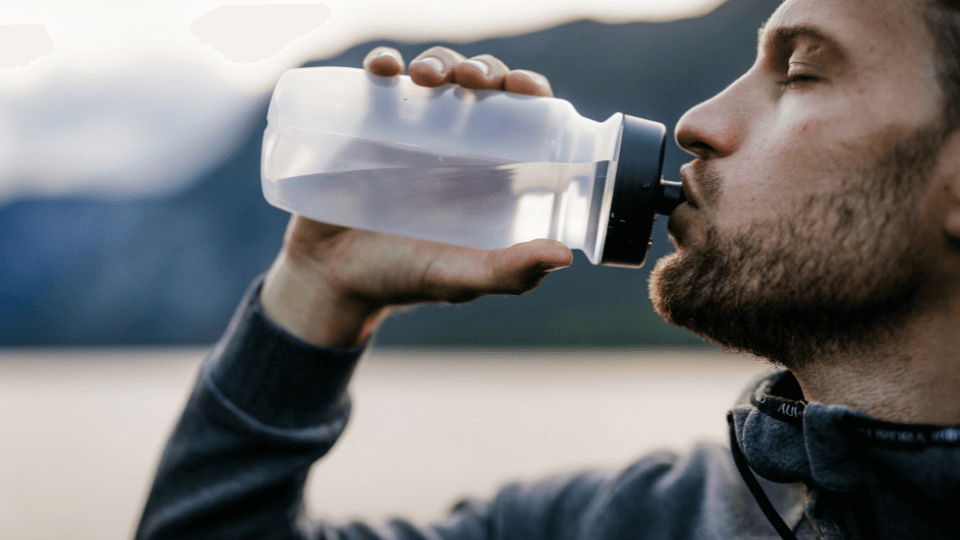
But Isn’t Sugar Bad?
For some, the fact that sports drinks have sugar terrifies them. Yes, it’s true that sports drinks have sugar, but as we know, sugar is just a type of carbohydrate. In sports drinks, the presence of sugar has two purposes:
- Easily digestible form of readily available fuel in a small volume
- Helps facilitate the absorption of electrolytes and fluid
Without sugar, sports drinks wouldn’t be as effective at fueling and hydration. If you’re getting stuck on the fear of sugar, consider the chemistry of the energy separate from the concept of sugar.
Sports drinks provide energy in the form of sugar. A 20 oz Gatorade offers 140 calories. Those calories come from 36 grams of carbohydrate, mostly in the form of sugar. But forget the word sugar for a moment. In terms of carbohydrate (the overarching nutrient), this is the same as having 9 teaspoons of sugar OR 1 small box of raisins OR 2 slices of bread OR ~ ¾ cup of cooked rice or pasta OR 1 KIND bar OR 1 cup cooked oats OR 2 ½ cups of strawberries OR 1 ⅓ medium banana OR 2 large apples OR 6 cups of broccoli.
All of these could be options for fueling and refueling to get the same amount of carbohydrate, but not all of these foods provide the same nutrients, satisfaction, or volume of food. And what you use to fuel changes depending on whether you need fuel before, during, or after a workout. Can you imagine trying to eat 2 ½ cups of strawberries or 6 cups of broccoli to fuel mid-run? Yikes, probably not a good idea. The point is depending on where you are in your day and how you want to feel, you may choose a different food to meet your nutrient needs.
Tips For Choosing Sports Drinks?
Sports drinks are not required for anyone and everyone exercising or training. (This is important to remember throughout our hydration education!) But they are a convenient tool for heavy sweaters, those training over an hour, and/or those training in hot weather to balance hydration. Most sports drinks provide electrolytes (typically from sodium) and are mixed with water to hydrate. In general, they have similar amounts of sugar and calories, because the ratio of sugar, fluid, and electrolytes is reasonably well standardized to hydrate during physical activity without upsetting stomachs (which is why it’s not ideal to water them down or over concentrate them – it can reduce their effectiveness). But note some drinks can have caffeine and/or protein in them. These are sport-specific additions and not right for everyone.
There are many options for sports drinks. The most common and readily available at most major retailers are Gatorade and Powerade. But there are other brands, including Scratch Labs and Hammer products. (Nuun is another popular product, but it does not have sugar and, as such, doesn’t provide energy. It’s designed to be taken with another glucose source while training and/or in addition to meal/snack before/after training).
Hydrating for training is a unique topic with lots of variables to consider. Every active body needs to be fueled and hydrated to perform its best. Sports drinks are a valuable and convenient tool to simplify the process, but they’re not required across the board. It is possible to do it with real food, but sports drinks are particularly valuable during exercise, to stay energized and fueled.
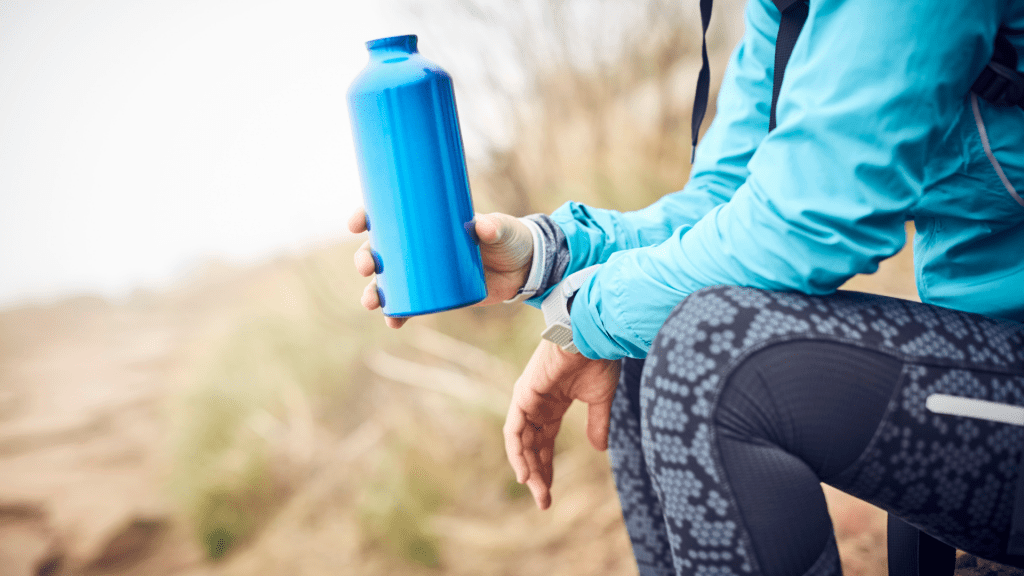
Key Takeaways on Hydration Education
There is a lot to unpack when it comes to hydration education. And there are a lot of variables unique to the individual when determining necessary water intake and hydration requirements.
Throughout all our nutrition lesson plans, we steer clear of saying anything is GOOD or BAD. Instead, we want to provide context for all the different possibilities someone might come across when making nutrition and hydration decisions. So with a thoughtful hydration education, children to adults can determine what their body needs when it comes to total fluid intake throughout a day.
More importantly, each day brings on different and varied challenges that might alter the amount of water intake we need. What works one day, may not be enough for another. But with hydration education we can grab our water bottles and feel confident with the hydration decisions we make throughout our life. Furthermore, we can determine what other types of hydration needs we might have via sports drinks or other beverages.
Like we said earlier, our body is made up mostly of water. So the more we can understand and listen to our bodies hydration status, the better we can support our body with what we need!
